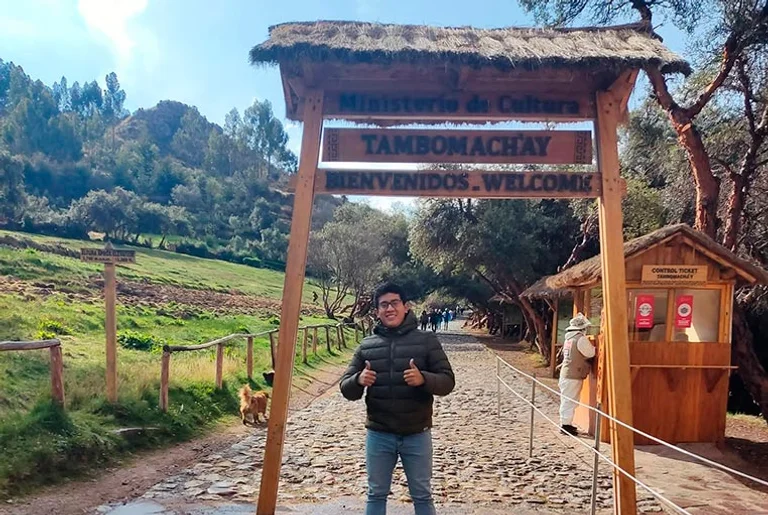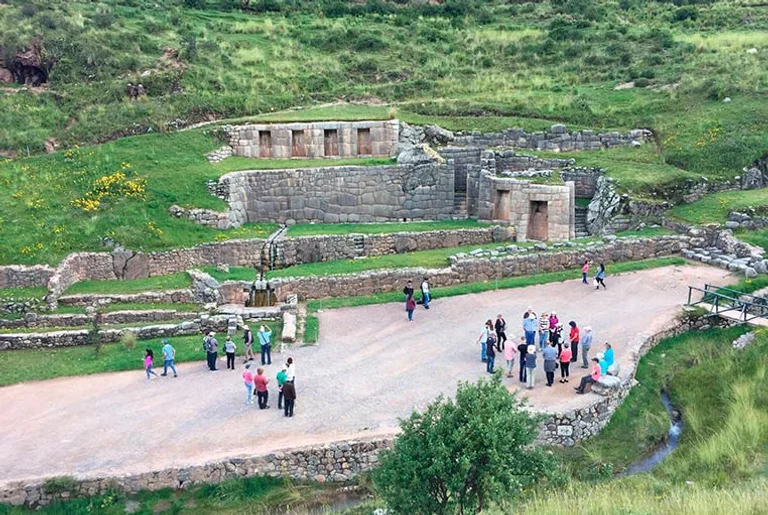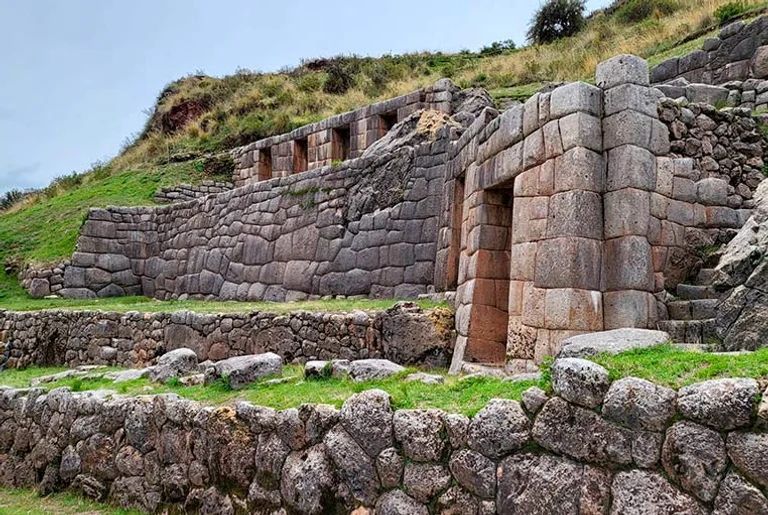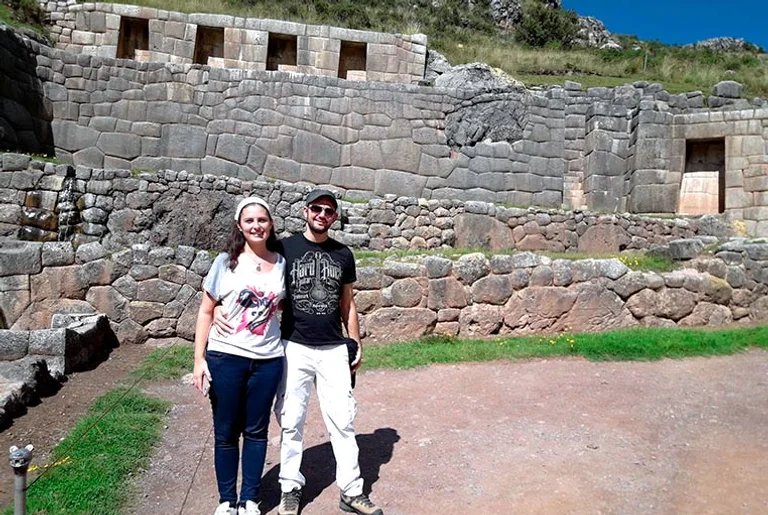
November 10, 2025
To go or not to go to Tambomachay? This will help you decide
Is it worth visiting Tambomachay, or is it just another stop along the way? If you’re unsure about including it in your Cusco itinerary, here you’ll find everything you need to make a good decision. There are details that few people mention, and they might just change your mind.
History and meaning
What is the origin of Tambomachay?
Tambomachay was built during the height of the Inca Empire, around the 15th century, under the rule of Inca Pachacútec. It is located about 8 kilometers north of the city of Cusco, and its construction is linked to the worship of water, a sacred element for the Incas. The choice of this site was not random, as the natural springs that flow in the area were considered pure and of divine origin.
Archaeologists have determined that its architecture was carefully designed to channel and distribute water through aqueducts, canals, and fountains—many of which still function today. Its construction, made with finely carved stones fitted with precision, demonstrates the high level of hydraulic engineering developed by the Incas.
What does the name Tambomachay mean?
The name “Tambomachay” comes from two Quechua words: tampu, meaning “lodge” or “resting place,” and mach’ay, which can be translated as “cave” or “shelter.” Thus, Tambomachay could be interpreted as “resting place in the cave” or “rest lodge,” suggesting that this site was designed as a space for rest or retreat, possibly intended for the Inca elite.
However, the term is also associated with ceremonial activities, especially those related to water and fertility. The word machay is also linked to sacred or spiritual retreat sites. Therefore, beyond being just a physical lodging, the name may also refer to a space with ritual and symbolic significance within the Andean worldview.
What was Tambomachay used for during Inca times?
Tambomachay served mainly as a ceremonial center dedicated to the worship of water. For the Incas, water was not only essential for agriculture but also a sacred element associated with fertility, purification, and life itself. The site’s hydraulic structures allowed water to be channeled with remarkable precision, suggesting that it was not an ordinary place but one designed for specific rituals.
In addition to its ceremonial function, some researchers believe that Tambomachay may have been an exclusive resting place for the Inca or members of the nobility during their journeys between Cusco and the Sacred Valley.

How to get to Tambomachay
How to get to Tambomachay from Cusco?
To reach Tambomachay from Cusco’s historic center, you have several options. The most common is to take a taxi or private tourist transport, as the site is located about 8 kilometers from the center along the Cusco–Pisac road. The trip takes between 10 and 15 minutes, depending on traffic and your starting point. There are also organized tours that include Tambomachay as part of the City Tour.
Another option is to use public transportation. You can take a small bus or van (“combi”) from Tullumayo Avenue or Av. del Sol toward Pisac or Calca and ask the driver to drop you off at the entrance to Tambomachay. Although it’s more affordable, this alternative can be a bit less comfortable if you’re carrying luggage or traveling during rush hours.
Note: To visit Tambomachay, it is mandatory to have the Cusco Tourist Ticket. You can purchase it in person or book it with us to avoid any inconvenience. That way, you can focus solely on enjoying the experience.
How much does transportation to Tambomachay cost?
If you take a taxi from downtown Cusco, the approximate cost ranges between 20 and 30 soles, depending on the time of day, traffic, and negotiation with the driver. If you’re traveling in a small group, this option is convenient and fast, especially if you want to visit nearby sites such as Puca Pucara or Sacsayhuamán.
On the other hand, if you choose to go by public transport, the fare costs between 1.50 and 2.50 soles per person. This is the most economical option, but it involves walking a few minutes from where the bus drops you off to the entrance of the archaeological site. You can also book a full tour that includes transportation and a guide, which may cost from 50 soles and up, depending on what’s included.
Can you walk to Tambomachay from Cusco?
Yes, it is possible to walk from Cusco to Tambomachay. From the historic center to the archaeological site, it’s about 8 kilometers, and the walk takes approximately 1 hour and 30 minutes to 2 hours, depending on your pace and physical condition.
Along the way, you’ll be ascending through paved roads and ancient Inca trails, passing other archaeological sites like Sacsayhuamán, Q’enqo, and Puca Pucara. It’s an excellent way to connect with the landscape and make the most of your visit, though it’s recommended to bring water, sunscreen, and be prepared for the altitude, as the route includes some steep sections.

Tambomachay as part of a tour
Which tours include Tambomachay?
Tambomachay is included in several archaeological tours around Cusco. One of the most common is the City Tour, which visits the main sites near the city, such as Sacsayhuamán, Q’enqo, Puca Pucara, and of course, Tambomachay. This tour is usually done in the afternoon and lasts about half a day—ideal for those arriving in Cusco and wanting to acclimate.
Is Tambomachay part of the Cusco City Tour?
Yes, Tambomachay is part of the traditional Cusco City Tour itinerary. This tour, one of the most popular among visitors, combines sites in the historic center—such as Qoricancha—with archaeological sites located on the outskirts, like Sacsayhuamán, Q’enqo, Puca Pucara, and Tambomachay.
Including Tambomachay in the City Tour allows visitors to learn more about the Inca hydraulic system and their worship of water. Although the visit to this site is relatively short, it’s a valuable opportunity to understand its religious significance and connection to the Andean worldview.

Tips for your visit
Are there restrooms at Tambomachay?
Yes, there are restrooms available for visitors at the main entrance of Tambomachay. These bathrooms are located outside the archaeological complex, near the ticket office, so it’s best to use them before entering the site since there are no sanitary facilities inside the archaeological area.
This is especially important to keep in mind if you’re visiting with a group or children, as there are no other options once inside. Moreover, since it’s a protected area, building additional facilities within the complex is not permitted.
Is there cell phone signal or internet?
At Tambomachay, cell phone signal can be limited or intermittent, depending on your carrier. Some areas near the entrance have acceptable coverage, but once inside the archaeological site—especially in higher or more remote areas—it’s common to lose signal.
As for internet, there’s no public Wi-Fi available. For that reason, if you need to stay connected, it’s best to send messages or make calls before entering. It’s also helpful to download maps or information beforehand if you plan to explore the site on your own without a guide.
Can you bring food or drinks?
Yes, you can bring food and drinks, but responsibly. Eating inside the archaeological area is not allowed to avoid leaving waste or harming the environment. However, you can bring snacks and water to consume in the nearby rest areas or before entering the site.
It’s recommended to bring a reusable water bottle, as the climate can be dry and the walk requires staying hydrated. It’s also important not to leave any trash or food scraps, since Tambomachay is a protected heritage site, and keeping it clean is everyone’s responsibility.
Note: We recommend visiting Tambomachay early in the morning. There are fewer people, the weather is cooler, and you can walk around the site more peacefully. Plus, you’ll get better photos without crowds.
Is it recommended for children or elderly people?
Yes, Tambomachay is accessible for children and elderly visitors, as long as they have adequate mobility. The path from the entrance to the water fountains is short—about a 10- to 15-minute walk—with a slight incline. Although the terrain isn’t too rough, it can be a bit demanding for those not used to walking at high altitude.
It’s recommended to bring hats, sunscreen, and water, as the sun can be strong despite the cool weather. For older visitors, it’s best to take the walk slowly and rest if needed. Many people enjoy it without issues, as long as proper precautions are taken for the altitude (over 3,700 meters above sea level).

Frequently Asked Questions
1. How far is Tambomachay from downtown Cusco?
Tambomachay is about 8 kilometers from downtown Cusco, approximately a 20-minute drive.
2. Is a guide necessary to visit Tambomachay?
It is not mandatory, but having a guide helps to better understand its history and archaeological significance.
3. Can you take a taxi to Tambomachay?
Yes, you can take a taxi from Cusco to the entrance of Tambomachay. There is also shared transportation that passes through the area.
4. How much time is needed to tour Tambomachay?
The visit takes between 30 minutes to 1 hour, depending on your pace and interest in exploring in more detail.
5. Can I use the Partial Tourist Ticket to enter?
Yes, Tambomachay is included in the Partial Tourist Ticket Type I (Sacsayhuamán circuit).
6. Is the path to Tambomachay steep?
The access from the entrance is short with a slight incline, easy to walk for most visitors.
7. Is photography or video recording allowed?
Yes, taking photos and videos for personal use is allowed at no extra cost. For professional use or drones, permission is required.
8. Is Tambomachay accessible for people with reduced mobility?
Not completely. The path has uneven stones and some slopes that may make access difficult.
9. Can Tambomachay be visited during the rainy season?
Yes, it can be visited all year. It is recommended to bring a raincoat or umbrella between November and March.
10. Are there restaurants or shops near Tambomachay?
At the entrance, there are some small shops selling snacks and drinks. For more options, it’s better to return to Cusco.